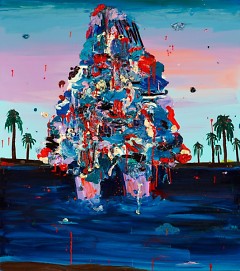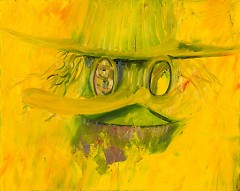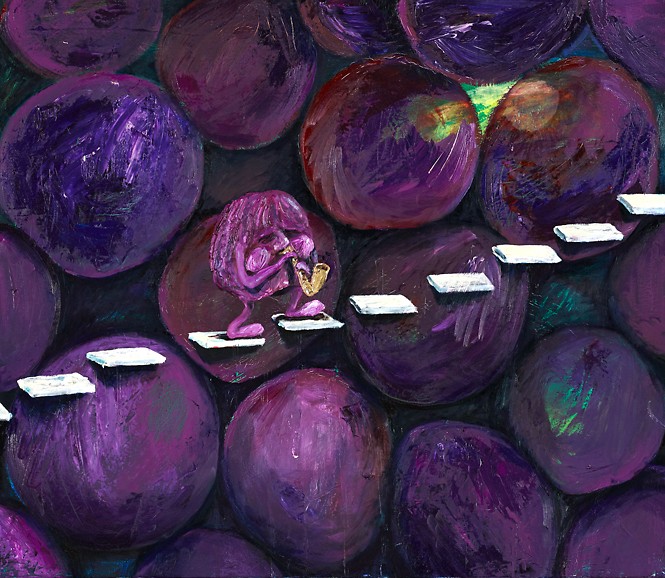There’s a collection of funny, grotesque, brilliant work on view at the Urban Institute for Contemporary Art (UICA) right now. Buying Friends: The Kortman Collection is on view through February 15.
There’s also a collector’s talk and catalogue signing this Friday, January 9, at 7:00 pm.
The exhibition consists of over 80 works by 36 artists, mostly colorful, goofy figurative paintings, with a few sculptures and photos as well. The works belong to the private collection of a young collector named Ryan Kortman. Based in Chicago, Kortman is originally from West Michigan and maintains ties here. While it seems a little odd for a nonprofit, non-collecting art space like UICA to feature a private collection, the work is so refreshing and irreverent that its organizing principle doesn’t matter much.
The paintings steal the show. Over a dozen different artists are playing with figurative painting in a way that’s aware of the material and conceptual history of the medium, while relishing in being funny, intentionally awkward and just downright weird.
Paint is a gross substance. Touching wet oil paint is a mistake: it sticks to you, it stains fabric and it leaves a smell. It’s like a toxic version of butter- good in the right context, but not something you want all over your skin or clothing. There’s an allure and revulsion held in balance in a lot of the paintings on view. These artists are thinking about paint as a material, not merely a medium used to render an image. Paint is stuff that’s worth considering on both cultural and chemical terms, and they don’t let us forget that. Their approach to the materiality of paint is not heroic or overly intellectual. There’s an awareness that this material is gooey, staining, sloppy, feeble and embarrassing. What should an artist build with this viscous sludge? Pictures, yes, but not just any pictures. Pictures of puerile fantasies and deranged myths.
There’s some jarring and memorable work in Buying Friends, but most of it operates on the same wavelength. The show is a bit like an album where all the tracks sound pretty much the same, but you don’t mind because they’re all good. At times it reads like each artist is doing their interpretation of the same joke. While a greater variety of approaches would be nice, the repeated subjects, material and sense of humor sets the tone well. Even the most absurd works feel right at home.
There are too many examples of messy, funny and physical figurative paintings to go into here, so I’ll dig into just one piece that stuck with me. Ian Hokin's "Coming Home" is a painting of a lone California Raisin solemnly ascending white stairs while playing the saxophone. The stairs appear as planks floating in front of a backdrop of enormous purple grapes. As a narrative fragment, it's as pathetic as it is darkly comic. The stairs have an ivory-like grace to them, but the grapes deploy a painfully bad paint application to brilliant effect. The choppy, goopy palette knife scratches of purple and white are perfectly amateurish. The grape skin is hard to look at, but retains a knowing wink. The texture seems to know, with a carefully calibrated intent, just how badly paint can be abused. Hokin accesses our memories of embarrassment and revulsion from having seen countless shit-surfaced paintings, to evoke an uneasy and awkward nostalgia.
"Coming Home" is a generation-specific joke about the thinness of nostalgia itself. There’s really not much point to remembering the California Raisins. Yet the act of remembering still has a strange pull. We want to share nuggets of pop culture nostalgia so badly that we sometimes force it, the way Hokin forces purple paint into hackneyed grape skin. That the painting can do this- use such intentionally shoddy technique to make a painting that’s flippant, profound, funny and deeply tragic- is remarkable.
Fluids and goos are embarrassing. There’s something scatalogical about painting. Poop, pee, blood, semen and viscera: there’s a guilty pleasure in the humor and fascination of these things, much the same way there’s a guilty pleasure in creating figurative paintings in a method that’s so clearly tuned in to the materiality of paint.
There’s a sense that if an artist takes the material nature of paint seriously, that shift will accompany a turn away from figurative subjects. Why worry about narrative, allegory and symbolism when we’ve accepted that the ultimate reality of a painting is pigment in a binder on a surface? Why go back down the narrative road? Why turn the plane back into a window?
According to these artists, because it’s hilarious.
This type of show is rarely seen in Grand Rapids. Which is sad because the work is good, and because presenting a show like this is not nearly as hard as showing a lot of other things that don’t usually find their way to Grand Rapids. When the Grand Rapids Art Museum (GRAM) presented Real/Surreal on tour from The Whitney- a sort of rich grandpa to Buying Friends- that was a big deal, and no small task in terms of funding and logistics. Artists like the ones in Buying Friends are considerably lower hanging fruit.
There are thousands of brilliant early to mid-career artists doing surprising, delightful and mind-bending things. Some are easier to show than others, but Buying Friends left me wondering why there aren’t shows like this in Grand Rapids all the time.
The Rapidian, a program of the 501(c)3 nonprofit Community Media Center, relies on the community’s support to help cover the cost of training reporters and publishing content.
We need your help.
If each of our readers and content creators who values this community platform help support its creation and maintenance, The Rapidian can continue to educate and facilitate a conversation around issues for years to come.
Please support The Rapidian and make a contribution today.


